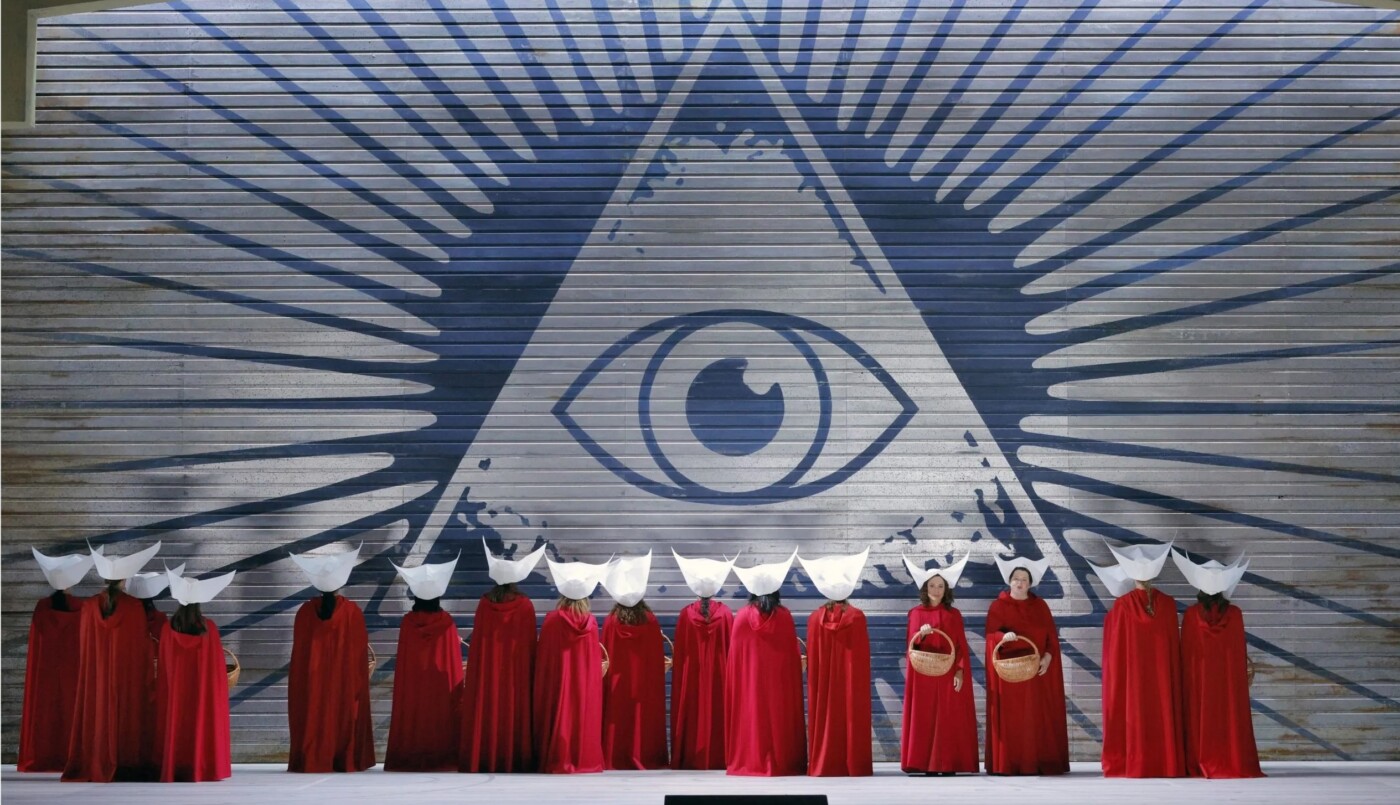San Francisco Opera’s West Coast premiere Sept. 14 of Poul Ruders’ “The Handmaid’s Tale” based on Margaret Atwood’s popular futuristic 1985 novel unusually speaks to audiences about issues in the news today.
The two-act opera about a dystopian world where a theocratic regime forces women to bear children was slated for the pandemic-canceled 2020-21 season, before the choice-affirming Roe v. Wade was overturned in 2022 and before some states banned books like “The Handmaid’s Tale” in public school libraries for being “sexually explicit.”
“Presenting this work feels more important than ever—it is essential that opera tells stories that connect with audiences now, that enable us to feel, think and consider,” says associate director Lucy Bradley, who held the position for the opera’s 2022 production at the Royal Danish Theatre in Copenhagen, where it premiered in 2000.
Bradley says when Atwood was in Berlin writing the book (which she calls a masterpiece that asks readers to question authority), it was an era known for a different wave of feminism. Still, many of its points remain prescient 40 years later.
“That the book is banned in so many states is unthinkable,” Bradley says. “The overturning of Roe v. Wade and the rolling back of abortion law in this country is devastating, and the fight to control women’s bodies in the name of religion continues from the U.S. to Iran and Afghanistan, repeatedly seeming to lift from the world of ‘The Handmaid’s Tale.’”
In “The Handmaid’s Tale,” which is set in an America where democracy has been replaced by a theocracy called Gilead, narrating heroine Offred (soprano Irene Roberts) has been torn from her family and forced into the “handmaid” class of women in reproductive servitude to a “commander.” In Offred’s case, as her name suggests, “The Commander” is Fred (bass John Relyea).

Staging the opera “The Handmaid’s Tale” (the story was adapted into a 1990 film with a screenplay by Harold Pinter and a 2017 TV series on Hulu) is challenging, says Bradley, because time (in Offred’s mind) flashes back and forth in Paul Bentley’s libretto and Ruders’ score.
“There are elements that the libretto couldn’t translate to the stage,” Bradley says. “Offred’s life as a handmaid is often experienced in stasis, waiting for something to happen to her. She is in a state of rumination because she has so much time to think. This wouldn’t make for a very interesting opera, so Paul and Poul have done a fantastic job at drawing out the drama of the story and making a compelling and driven adaptation one that remains very true to the text.”
Ruders, a composer of orchestral, chamber and vocal music whose operas include 2016’s fairytale work “The Thirteenth Child,” has written a score for “The Handmaid’s Tale” that’s notable, Bradley says, for its direct, visceral nature and complexity.
“There are so many varied sounds and textures within the orchestral world, used to huge impact,” Bradley says, “from chimes and moments of hymn-like simplicity to electronic sounds that feel otherworldly and strange. There are moments of high tension supported by incredibly high strings, moments of violence that feature repeated horn and percussion phrases and sections of driving energy, which feel like the cogs of Gilead turning. There are relentless passages that leave the audience reeling followed by moments of incredible breath and space with unsupported voice, which are haunting and beautiful.”
Audiences likely will recognize at least one tune as “Amazing Grace,” but Ruders’ use of leitmotif or motifs to suggest particular characters might be just as memorable.

Mezzo-soprano Lindsay Ammann, who as The Commander’s barren wife Serena Joy is eager to take Offred’s child as her own, describes Ruders’ musical style as cinematic or “sound painting,” highlighting emotions the director wants to pull from the viewer.
“There are many characters that have musical quotes,” says Ammann, who is making her role and house debut in the upcoming production. “Just like in Wagner, the orchestration plays the quotes to kind of jog the memory towards a certain character…. My character Serena Joy usually has short chord clusters played. They are not pleasant—and neither is she!”
Although “Handmaid” has the evil Commander and the handmaid-indoctrinating Aunt Lydia (soprano Sarah Cambidge), Ammann feels Serena Joy is the opera’s real villain, very much in an unforgettable way delivered with a personal touch.

“She was the scholar who wrote the texts that planted the idea of ‘Gilead,’ she indoctrinated Fred, and she lit the match for the fire,” Ammann explains. “But my Serena Joy is ‘Southern sweet.’ You know this woman, have met her at the gym or in a grocery store line. I want the audience to love to hate me, hate to love me. You want to be her and have nothing to do with her at all at the same time. The audience will also see Serena Joy in her alone moments. This definitely adds another layer to the depth of her psychosis. I’m aiming to make her as ‘meme-orable’ as possible!”
Enhanced by Christina Cunningham’s striking costumes (including the handmaid’s iconic red dresses) and otherworldly set design by Chloe Lamford, projections by Will Duke and lighting by Fabiana Piccioli, “Handmaid’s Tale” indeed has a serious takeaway message.
“Offred’s ability to speak directly to the audience helps us frame our production as Atwood intended it to be, a cautionary tale, one that asks its audience to sit up and pay attention to the freedoms that we take for granted and that could very easily be stripped away,” Bradley says.
San Francisco Opera’s “The Handmaid’s Tale” is at 7:30 p.m. Sept. 14, Sept. 17, Sept. 20, Sept. 26 and Oct. 1, and 2 p.m. Sept. 22 and Sept. 29 at the War Memorial Opera House, 301 Van Ness Ave., San Francisco. For tickets ($28-$438; $27.50 for Sept. 20 livestream), call (415) 864-3330 or visit sfopera.com.
The post ‘Handmaid’s Tale’ at SF Opera raises resonant, hot-button issues appeared first on Local News Matters.
